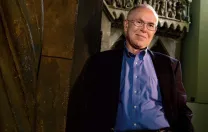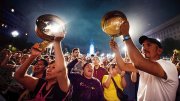The initiative for the science of the human past was a dream made possible when, in 2002, Goelet professor of medieval history Michael McCormick won a $1.5 million Distinguished Achievement Award from the Mellon Foundation. When he then sought out Cogan University Professor of the Humanities Stephen Greenblatt, who had won the award a year earlier, “He gave me the best advice that anyone could give,” McCormick recalls: “That this is a once-in-a-lifetime opportunity. That what you don’t want to do is intensify what you are already doing. You want to take this and do something impossible.”
Inspired, McCormick decided to organize a series of workshops on the science of human history. He had two goals: to bring together people who otherwise would never meet; and to generate new data. But before he began, McCormick asked the Mellon Foundation for two years to prepare, so that he could visit laboratories and excavations in Europe to find out who the experts were and what they were doing. This later enabled him to bring distinguished medieval archaeologists to Harvard as visiting scholars, to coordinate innovative scientific explorations at archaeological sites in Europe, and to organize technical workshops with specialists from relevant fields.
A workshop on the climate of the first millennium a.d., for example, brought climatologists, dendrochronologists, atmospheric scientists, and oceanic chemists together with historians and archaeologists. “I thought the historians would milk the climate scientists,” he recalls, “but it never really occurred to me that we had data that they wanted--they were going wild. People had told them it was a dark age and so there was no point working on it--they’d concentrated their efforts on the second millennium. Suddenly, they were seeing the details that we [historians] know about climate anomalies in the first millennium, which may include the closest analogue to the climate of the last decades of the twentieth century, and they were just very excited.”
A second workshop focused on what could be gleaned from human bones dating to the late Roman empire. “My most fun day in the last two years was my first contact with Mike” at that meeting, says Nick Patterson, a former cryptologist who now works on especially challenging problems in analyzing the genomic data streaming from the Broad Institute of MIT and Harvard. That day, Patterson recalls, “it was appalling weather--a whiteout blizzard.” Cloistered in a museum, “we were learning…amazing stuff. The revisionist history that had become mainstream was that the Roman empire in the West had never really collapsed, it just faded away. But a study of bones dug up in north Italy shows that the average human height at the time decreased something like six inches in around 50 years. And there is other evidence of malnutrition in the bones. The Romans had been importing enormous quantities of food, which they couldn’t do anymore. Agriculture had collapsed.” Though no scribe recorded this history, the bones did.
An initiative-sponsored lecture series has also covered diverse topics: how x-ray fluorescence identifies the Indian and Sri Lankan sources of late Roman and Merovingian jewels; how new environmental evidence explains the development of French towns; and how biological archaeological materials illuminate the economic history of the North Sea region. McCormick has done extraordinary work weaving seemingly exotic threads like these into new insights, partly from necessity.
“If you work on the fall of the Roman empire, or the dark ages of Europe, you work in a period which is not the richest in written sources,” he explains. “The kings, the top counts, the bishops, and the popes are pretty well documented. Once you get below that level, you get occasional insights, but it is kind of spotty. What was life like for children or for women? How can we find out about the voiceless? How can we find out about the stuff that never makes it into the written record, like climate and how it is changing; pollution; sickness of different types? And so I wanted to try and find a way of discovering new data. Not reinterpreting old data, but new data. And it appeared to me that the breakthroughs in the understanding of reality that are occurring in the natural sciences, and naturally find application in archaeology, would be of interest and value for addressing great questions: the fall of the Roman empire, the movements of people.”`






